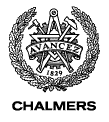General Information
There are 2 lab assignments but we have renamed the subparts using letters this year (as the numbering was confusing last year).
You should work in pairs (except for Lab C, see below).
If you have a good reason for doing the assignments by yourself,
please contact Nick, Mary or John. You need to pass all lab assignments
in order to pass the course.
The assignments should be handed in using the Fire system.
The final deadline for all labs is May 23 at midnight. That means that you should aim to have all labs finished (and preferably also approved!) by then. Each lab should, in addition, be submitted at least once before the initial deadline for that lab.
Submission
Clean Code
Before you submit your code, Clean It Up! Submitting clean code is Really
Important, and simply the polite thing to do. After you feel you are done, spend
some time on cleaning your code; make it simpler, remove unneccessary things,
etc. We will reject your solution if it is not clean. Clean code:
- Does not have long lines (< 80 characters)
- Has a consistent layout
- Has type signatures for all top-level functions
- Has good comments
- Has no junk (junk is unused code, commented code, unnecessary comments)
- Has no overly complicated function definitions
- Does not contain any repetitive code (copy-and-paste programming)
What to include
Your submission needs to include the following information:
- Your Haskell file (.hs or .lhs), containing your
solution. A single Haskell file is preferred. Call it LabYxx
where xx is your group number and Y is the letter name of that lab sub-part.
Do not submit .o, .hi or .exe files!
- report.txt or report.pdf, a file containing brief documentation
of what you have done. Answer the questions asked in the assignment.
Before you submit,
please read the note on cheating.
You are supposed to submit your solution using the Fire system.
Note: You do NOT have to use zip/gzip/tar/bzip on
your files! Just upload each file that is part of your
solution. Don't forget to submit when you have uploaded all the files.
Benchmarking Requirements (Haskell part)
Include Threadscope plots in the report and draw conclusions from
them
Draw conclusions from runtime statistics (+RTS -s)
Play with different granularities (for example by introducing a threshold or depth parameter).
To the Fire System
Tools
The stuDAT (Linux) computers have a recent Haskell Platform installed. We will also be using
Amazon's Cloud (EC2) to provide you with access to parallel machines. More on that shortly.
The GHC user guide contains a chapter about Using GHC (command-line arguments
and the like).
Threadscope is also available on the (Linux) stuDAT computers. (Type threadscope
at the prompt.)
To get the Haskell Platform for your own laptop, go to
the Haskell Platform page on haskell.org (which is a great source of Haskell info).
The Threadscope page includes information about how to use the tool, as well as how to install it.
Installing on Linux laptops seems straightforward. There are binary releases for Windows and Mac, thank goodness.
The slides from last year's lecture 3 by Andres Löh from Well-Typed are available and are about Threadscope and GHC events.
You should plan to get used to using Threadscope during the first week of the course.
Exercise 1 - Getting Started
Study the use of
Threadscope.
Write a simple merge sort program in Haskell and parallelise it
Details.
Lab A
Parallelising scan and a Fast Fourier Transform algorithm in Haskell. The lab description also contains pointers to interesting papers and slides.
Details
Lab B
GPU Programming in CUDA and Obsidian.
To install Obsidian:
cabal update
cabal install obsidian
Details [pdf]
The files referred to in the instructions for Lab B are inc.cu and LabB.hs. (The latter was slightly revised on April 19, so you may need to fetch
the new one.)
Some additional information about Lab B.
The deadline for resubmission has now been set to Friday May 10 at midnight.
References
CUDA programming manual
Markus Billeter, Ola Olsson, Ulf Assarson.
Efficient Stream Compaction on Wide SIMD Many-Core Architectures.
High Performance Graphics 2009.
[pdf]
Koen Claessen, Mary Sheeran, and Bo Joel Svensson. Expressive Array Constructs in an Embedded
GPU Kernel Programming Language.
In Proceedings of the 7th workshop on Declarative aspects and
applications of multicore programming, DAMP ’12, 2012.
[pdf]
Alex Cole, Alistair McEwan, Geoffrey Mainland. Beauty And The Beast: Exploiting GPUs In Haskell.
Communicating Process Architectures, 2012
[available at hgpu.org]
Ola Olsson, Markus Billeter, Ulf Assarson.
Clustered Deferred and Forward Shading.
High Performance Graphics (HPG), 2012.
[pdf]
Lab C
NESL-style programming and cost models. Repa programming. Writing a tutorial.
You need to get into groups of four for this lab.
Details
Lab D
Distributed Erlang and Map-Reduce
Details

